I. What are the Nucleotide Level and Chromosomal Mutations?
When we talk about mutations, they most likely won’t cause a zombie outbreak like in World War Z or the Walking Dead. However, mutations are an integral part of our biology and even a necessary part with their involvement in the evolutionary processes!
Funny enough, mutations can actually be divided into a couple of different categories: the way we’ll organize them is whether they classify into a nucleotide level (microscale) mutation or a chromosomal (macroscale) mutation.
This is definitely one of the main articles you’d want to focus on for the biochemistry portion of the MCAT as this is one of the most high yield MCAT concepts! This is because there are so many tie ins and overlaps that can be made with other content and topics!
II. Nucleotide and Chromosomal Mutations
As stated above, we’ll divide the different mutations into 2 categories: whether they are nucleotide level or chromosomal mutations. Let’s take a look at nucleotide level mutations!
A. Nucleotide Level Mutations
As indicated above, these types of mutations are best thought of as microscale mutations, as they deal specifically with nitrogenous base changes in the nucleotides.
Furthermore, these mutations can be broken down even further whether they’re either 1) point mutations or 2) frameshift mutations!
Point mutations deal with single nucleotide substitutions (SNS), where one base is replaced for another base. Frameshift mutations result in the misalignment of the triplet codon reading frame! Take a look at the diagram below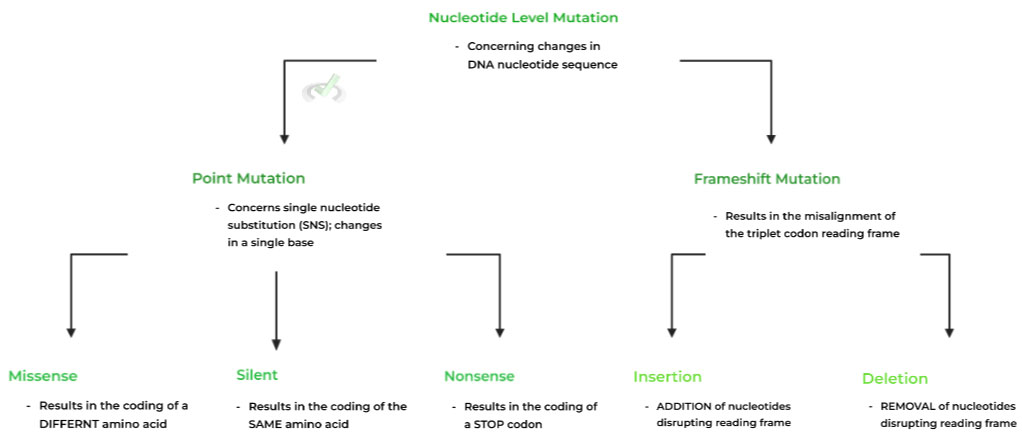
I. Point Mutations: Missense, Silent, and Nonsense
Recall that these mutations deal with single nucleotide substitutions (SNS). Look to the figure below to get a better understanding of the different mutations!
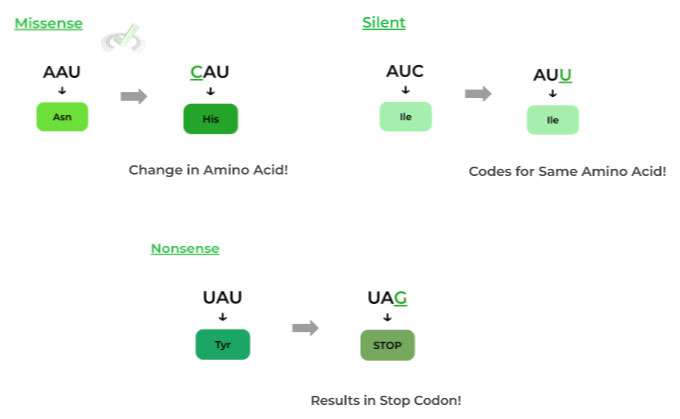
II. Frameshift Mutations: Insertion and Deletion
Likewise, these mutations deal with the disruption of the triplet codon reading frame. Again, look below to get a better understanding!
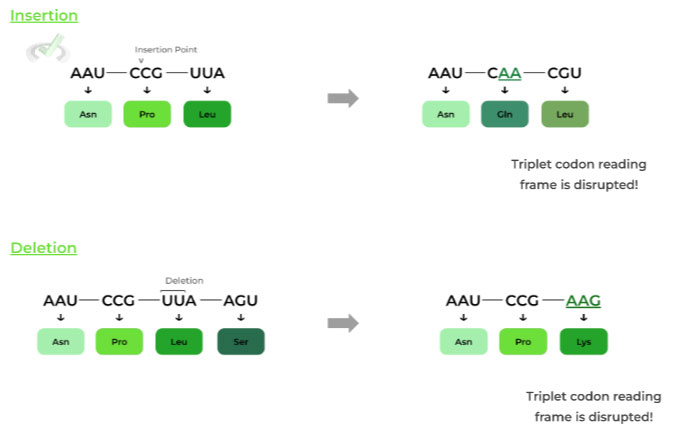
B. Chromosomal Level Mutations
Likewise, these types of mutations are characterized as macroscale mutations, as they deal with the large DNA segments of the chromosome rather than the individual nucleotides.
Similarly, these mutations can be broken down further into 2 categories: whether they deal with 1) a single chromosome or 2) double chromosomes.
Single chromosomal mutations deal with changes to a DNA segment of ONLY a single chromosome while double chromosomal mutations deal (not surprisingly), deal with the DNA segment changes of 2 chromosomes. Take a look at a similar diagram below!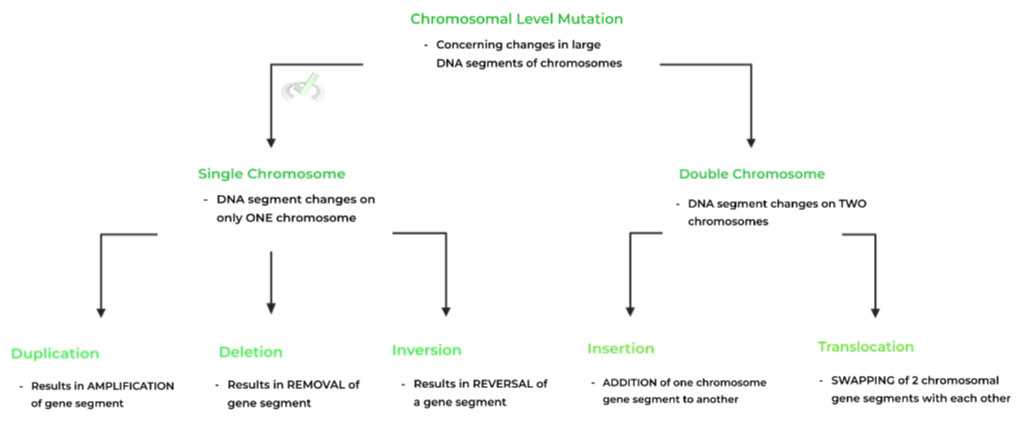
I. Single Chromosome: Duplication, Deletion, and Inversion
Recall that these chromosomal mutations deal with gene segments located on ONE chromosome. Look to the figure below to get a better visual understanding!
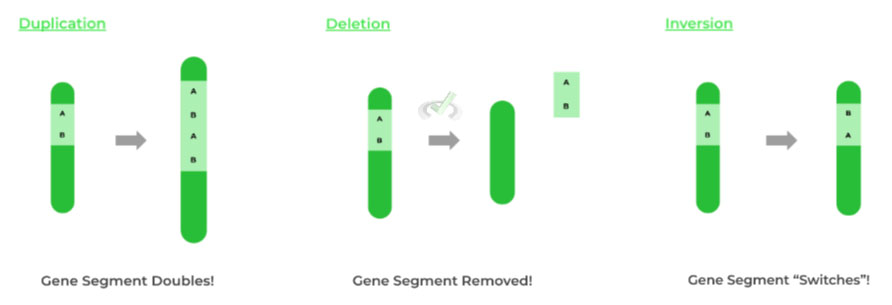
II. Double Chromosome: Insertion and Translocation
Likewise, these chromosomal mutations involved gene segment changes with 2 chromosomes. Look again below for a better visual understanding!
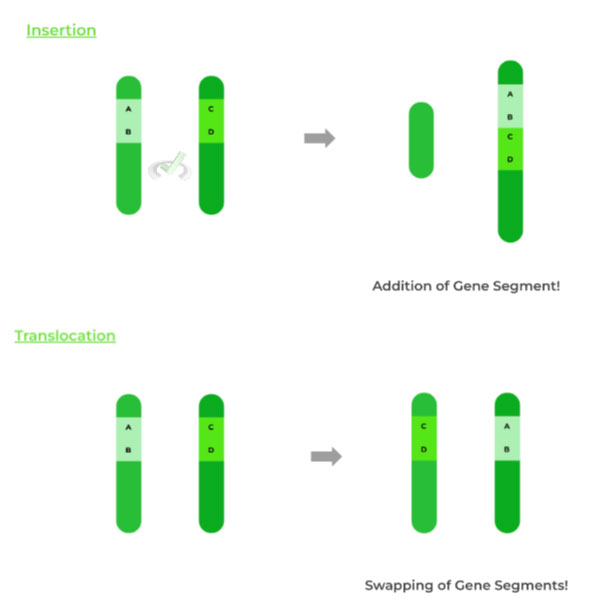
Hopefully the diagrams and figure above helped you guys in any way! This article was a bit different in the sense that it was more focused on visuals than textual information.
However, we believed that incorporating these visual aspects especially for this section was necessary, given the content!
III. Bridge/Overlap
With the likelihood of mutation incorporation is very high within the cells, there have been evolved strategies that can help protect cells from this mutation, namely the wobble pairing! Let’s take a look at this mutation protection mechanism!
I. Wobble Pairing
Mutations are actually quite common; in fact, RNA polymerase makes 1 transcriptional error for anywhere between 100,00 to 300,000 nucleotides. While it may not be a big error at first sight, it just takes one error for a crucial protein to become nonfunctional.
Although there have been various mechanisms that evolved in order to account for this, one we want to focus on in this article is the wobble pairing.
A wobble pairing occurs when a base pair DOES NOT follow conventional Watson-Crick base pairing. Recall that in Watson-Crick base pairing, adenine pairs with thymine and cytosine pairs with guanine.

A great example of a common wobble pairing is within the triplet codons! Notice how even though the THIRD nucleotide of the above codon sequences are different, they all code for the SAME amino acid!
This is to “protect” against any possible mutation! If the third nucleotide, for example, doesn’t follow Watson-Crick base pairing due to a mutation, the wobble pairing can “protect” against a possible amino acid change!
IV. Wrap Up/Key Terms
Let’s take this time to wrap up & concisely summarize what we covered above in the article!
A. Nucleotide Level Mutations
These mutations are best thought of as microscale mutations, as they deal with the individual nucleotides and changes within the bases of the nucleotides. They can be further broken down into point or frameshift mutations.
I. Point Mutations: Missense, Silent, and Nonsense
Point mutations deal with single nucleotide substitutions (SNS), where one place is replaced for another base.
These include missense mutations which code for a DIFFERENT amino acid, silent mutations which code for the SAME amino acid, and nonsense mutations which code for a STOP codon.II. Frameshift Mutations: Insertions and Deletions
Frameshift mutations result in the misalignment of the triplet codon reading frame. These include insertions which involve the ADDITION of nucleotides and deletions which involve the REMOVAL of nucleotides.
B. Chromosomal Level Mutations
These mutations, in contrast, are best thought of as macroscale mutations, as they deal with larger, genetic DNA segments of the chromosome. Likewise, they can be divided into single chromosome or double chromosome mutations.
I. Single Chromosome: Duplication, Deletion, and Inversion
These types of chromosomal mutations involve changes in the gene segments of only ONE chromosome!
These include duplications where the gene segments are AMPLIFIED, deletions where the gene segments are REMOVED, and inversions where gene segments are REVERSED.II. Double Chromosome: Insertion and Translocation
Similarly, these chromosomal mutations involved changes in the gene segments between 2 chromosomes!
These include insertions where there is an ADDITION of one chromosome gene segment to another chromosome and translocations, which involves the SWAPPING of gene segments between 2 chromosomes.
V. Practice
Take a look at these practice questions to see and solidify your understanding!
Sample Practice Question 1
After the discovery of a point mutation, researchers find that a protein originally 50 kDa is now only 20 kDA in size. What type of mutation could be responsible for this phenotypic change?
A. Missense Mutation
B. Silent Mutation
C. Insertion
D. Nonsense Mutation
Ans. D
As noted in the question stem, the protein drastically decreases in size. The most possible explanation for this would be a nonsense mutation as it codes for a stop codon. A stop codon encountered earlier will cause translation to terminate earlier as well, resulting in a shortened protein.
Sample Practice Question 2
Given the following codon sequence, GUU - GGG - AUA, several point mutations occur which result in this new, mutated codon sequence, GUU - GUG - CUA. Given that the sequence codes for the transmembrane portion of a protein, which of the following best describes the mutations that occurred and their effect on the transmembrane portion? – Use the codon table given below!
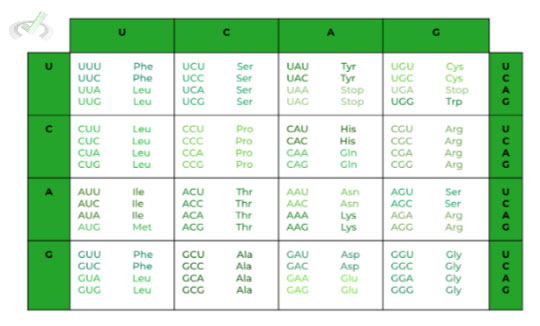
A. Missense Mutations; Insertion of the TM portion into the membrane is STILL favorable
B. Missense Mutations; Insertion of the TM portion into the membrane is NOT favorable
C. Silent Mutations; Insertion of the TM portion into the membrane is STILL favorable
D. Silent Mutations; Insertion of the TM portion into the membrane is NOT favorable
Ans. A
This question requires multiple steps and a combination of concepts, so let’s break it down one by one. First solve for what each sequence codes for: the first sequence will yield Valine - Glycine - Isoleucine while the second sequence codes for Valine - Valine - Leucine.
As shown, the point mutations code for a DIFFERENT amino acid, meaning these are missense mutations. Because this is the TM portion, it is favorable to have NONPOLAR amino acids. Even though the amino acids change in the second sequence, the resulting amino acids are still nonpolar, meaning that insertion is still favorable!







 To help you achieve your goal MCAT score, we take turns hosting these
To help you achieve your goal MCAT score, we take turns hosting these 





















 reviews on TrustPilot
reviews on TrustPilot